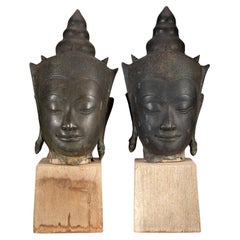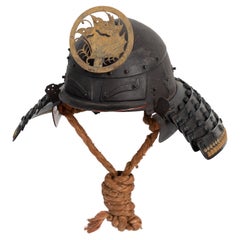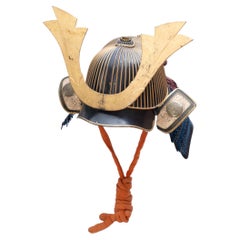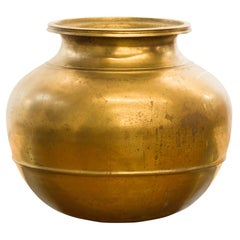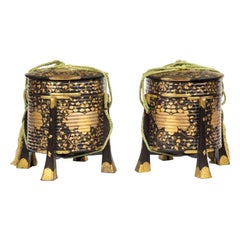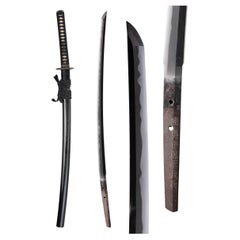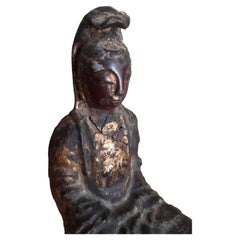17th Century Metalwork
22
to
2
12
8
22
22
22
1
143
831
804
32
436
183
39
42
14
23
10
10
12
16
9
2
1
21
9
8
3
3
20
15
11
4
3
Period: 17th Century
A Ming Dynasty Patinated Bronze Relief Work Vase Turned to a Lamp
Located in New York, NY
Hailing from the Ming period in 16/17th century, this monumental bronze vase is a fine example of the auspicious decor and markings unique to Chinese furnishings. The vase is cast wi...
Category
Chinese Ming Antique 17th Century Metalwork
Materials
Bronze
Pair of Antique Thai Ayutthaya Period Bronze Crowned Buddha Head on Wood Stand
Located in Forney, TX
A remarkable pair of Thai Ayutthaya period bronze crowned Buddha mounted on wood display stands. Thailand. 17th/18th Century
Dimensions: (approx)
Head: 15" High, 7.75" Wide, 6" Deep (tallest)
Overall: tbd
Provenance / Acquisition:
Acquired from the highly reputable auction house Heritage Auctions, Dallas, Texas.
2024 March Fine & Decorative Asian Art Signature Catalog Auction #8155 Lot #78357
Condition Report:
Attractive pair with beautifully aged patina, condition commensurate of age, use, and exposure. Scattered areas of desirable verdigris green patina and oxidation throughout to each. Minor loss to front shell point of one example. Small holes scattered throughout and scews/nails through each fixing both examples to wooden bases. Both well preserved and present superbly
History:
The first Crowned Buddha images or Jambupati Buddha statues are known to have been originated from the Pyu, where the Indian influence of Buddhist arts and non-Theravada Buddhism was extremely felt in those days. There may have been various background stories behind the crowned Buddha statues in the course of history but one of the most popular stories goes by the legend of Jambupati. This particular legend is not known in the home of Buddhism India, however the crowned Buddha statues have been attached to the name Jambupati as the Buddha is believed to have humbled a boastful and arrogant king Jambupati. The story goes on about how the Buddha transformed himself into a mighty king with a crown and jewelry and set himself a majestic yet incomparable palace. Seeing this, the king accepted the great ability of the Buddha and submitted himself to the Dharma and became a Buddhist monk. This particular story has gained a lot of popularity and stood the test of time in Burma as the number of Crowned Buddha statues in Burma is considerably great in amount.
There are also other versions of the background story of crowned statues...
Category
Thai Folk Art Antique 17th Century Metalwork
Materials
Bronze
Chinese Brass Hot Water Bottle with Floral Relief Pattern
Located in Chicago, IL
This squat brass vessel is an early Qing-dynasty hot water bottle, originally used to heat a bed or warm the body. The round container would have been filled with hot water through t...
Category
Chinese Qing Antique 17th Century Metalwork
Materials
Brass
Rare Islamic Illustrated book Cover Manuscript Antique Indian Persian 17 th C
Located in London, GB
A Rare Early Islamic Illustrated book cover Antique Asian Islamic Indian Mughal Persian 17 th c
Very finely detailed hand illustrated featuring a ki...
Category
Indian Antique 17th Century Metalwork
Materials
Paper
Okitenugui Kabuto Samurai Helmet Shaped as a Head Towel Saika, Early Edo Period
Located in Milano, IT
Okitenugui kabuto
Samurai helmet shaped as a head towel
Saika, early Edo period, 17th century
The Haruta armorers who moved to Kii province in the early 17th century, took the name from the village where they worked, Saika, near Wakayama, possibly on request of the local daimyo, Asano Yukinaga, a great armour amateur. Specialised in the construction of plate helmets, they produced mainly two typologies of kabuto: one with six plates covered with a chrysanthemum-shaped plate on top and one shaped as a “head towel”, called okitenugui. The latter type of kabuto employs very heavy plates crafted in a curved manner and was improved in order to make it resistant to firearms.
This okitenugui kabuto features some distinctive decorations of the Haruta school, including the application of cut-out iron elements, including eyebrows, washers and lozenge-shaped decorations on the sides. The ring on the top, however, is a rare feature and could be used to hold a small war flag.
Category
Antique 17th Century Metalwork
Materials
Iron
Sujibachi kabuto 62-plate samurai helmet Haruta school, Edo period
Located in Milano, IT
Sujibachi kabuto
62-plate samurai helmet
Haruta school, Edo period
17th-18th century
A lamellar helmet consisting of sixty-two plates joined with five rows of rivets. The surface is...
Category
Japanese Antique 17th Century Metalwork
Materials
Iron
Big Antique 17th century key
Located in Chonburi, TH
This Antique 17th-century wrought iron key is a fascinating artifact that transports us back to an era of intricate craftsmanship and timeless elegance. T...
Category
Dutch Antique 17th Century Metalwork
Materials
Wrought Iron
Chinese Bronze Scholar Vase with Taotie, Ming/Qing Dynasty, 17th century, China
Located in Austin, TX
A small and interesting cast bronze archaistic scholar vase with loose ring handles and taotie mask design, late Ming or early Qing Dynasty, mid 17th century, China.
The small vase of archaistic hu form, and cast with archaistic designs. Sitting on a tall splayed ring foot, the round body is cast with a large band featuring a ferocious taotie (ogre) mask. The taotie mask in this case id decidedly feline, with a ruyi shaped snout above a whiskered mouth. Two flanges stick out to either side of the mask, reminiscent of ears.
A wide, tall neck rises from the body, terminating in a slightly everted mouth. The archaistic cast design on the neck is not as clear, but most likely represents Fusang, a mythical island in the Eastern Sea where the legendary Fusang tree grows. The Fusang tree, home to the mythical Sun Bird...
Category
Chinese Qing Antique 17th Century Metalwork
Materials
Bronze
Chinese Bronze Chilong Garlic Head Scholar's Vase, Qing Dynasty, 17th C, China
Located in Austin, TX
A small and lovely Chinese cast bronze garlic head scholar's "chilong" vase, early Qing Dynasty, Kangxi period, late 17th century, China.
The elegant vase of beautiful proportion...
Category
Chinese Qing Antique 17th Century Metalwork
Materials
Bronze
Chinese Archaisitc Bronze Small Scholar Vase, 17th Century, China
Located in Austin, TX
A fine small archaistic scholar's vase in the form of a zun, Ming to Qing Dynasty, 17th century, circa 1650, China.
The small vessel of elegant proportions and wonderfully cast. T...
Category
Chinese Qing Antique 17th Century Metalwork
Materials
Bronze
Splendid and Heavy Late 17th Century Dutch-Colonial Silver Filigree Salver
Located in Amsterdam, NL
A splendid and heavy Dutch-colonial silver filigree salver
Indonesia, Batavia (Jakarta) or possibly Padang, West Sumatra, 2nd half 17th century
Diam. 22.9 cm
Weight 551 grams
This filigree-work was probably done by Chinese masters...
Category
Indonesian Dutch Colonial Antique 17th Century Metalwork
Materials
Silver
Tōkanmuri Kabuto Samurai Helmet in the Shape of a Court CAP
Located in Milano, IT
Tokanmuri kabuto
Samurai helmet in the shape of a court cap
Momoyama to early Edo Period
17th century
The wearing of helmets that reproduced the shapes of traditional ...
Category
Japanese Antique 17th Century Metalwork
Materials
Iron
17th Century Chinese Bronze Censer & Cover with Jade Finial Top and Wood Base
Located in New York, NY
A Fantastic and Rare 17th century Chinese Patinated Bronze Censer & Cover with Jade Finial Top and Wood Base. The body of this censor is intricately decorated with Archaistic decoration in hand-chassed relief. The wooden lid is designed with a foliate, leaf-like form, with a gorgeous white jade finial in the shape of a lotus leaf. The gorgeous tripod censer stands...
Category
Chinese Qing Antique 17th Century Metalwork
Materials
Bronze
Gold Ornaments of Antique Chinese Buddha Statues / 17th-19th Centuries
Located in Sammu-shi, Chiba
This is thought to be part of the decoration of a gilt-bronze Buddha made in ancient China, from the late Ming to the Qing dynasties.
It is thought that it is probably an ornament t...
Category
Chinese Ming Antique 17th Century Metalwork
Materials
Copper
Pair of Japanese Edo Period Iron Silver Inlaid Red Lacquered Stirrups 'Abumi'
Located in New York, NY
A Pair of Japanese Edo Period (1603–1867) iron, silver inlaid, and red lacquered stirrups (Abumi). Each of typical form, made of iron with silver inlay on the front with floral bloss...
Category
Japanese Edo Antique 17th Century Metalwork
Materials
Iron, Silver
Koboshi Kabuto, Samurai Helmet with Standing Rivets Haruta School
Located in Milano, IT
Koboshi kabuto
Samurai helmet with standing rivets
Haruta School
Early Edo Period, 17th century
A 62-plate koboshi-bachi [helmet bowl with small s...
Category
Japanese Antique 17th Century Metalwork
Materials
Iron
Antique Chinese Cloisonné Enamel Gu Form Vase, 17th/18th Century, Kangxi Period
Located in New York, NY
A Fantastic, rare, and antique Chinese Cloisonné Enamel Gu Form vase, 17th/18th century, Kangxi Period. This cloisonne vase is extremely rare to find in this quality, condition, age,...
Category
Chinese Qing Antique 17th Century Metalwork
Materials
Bronze
Dutch Colonial Silver Dish with the Von Pfeffel Coat-of-arms, 17th Century
Located in Amsterdam, NL
An unusual Indonesian lobbed silver dish
Jakarta (Batavia) or Coromandel coast, third quarter 17th century, apparently unmarked
The eight lobbed dish exuberantly decorated with floral motifs, with the middle section replaced, consisting of indistinctly marked German silver from the early 19th century, bearing the coat-of-arms of the Von Pfeffel family.
Diam. 30.5 cm
Weight 461 grams
Note:
Lobbed silver dishes with exuberant floral decorations were characteristic of the decorative arts in the Netherlands in the first half of the 17th century. This style of floral decoration was adopted by silversmiths as well as by furniture makers working on the Coromandel Coast and in Batavia, often by workers who had fled the Coromandel Coast because of war and famine. In Batavia this style was known as “Custwerck” (work from the Bengal coast).
These lobbed dishes are seldom marked. Only after 1667 the use of the town mark became obligatory in Batavia but only for silver made in Batavia not for silver imported in Batavia from other VOC settlements. The engraved coat of arms in the centre is a replacement of the original centre.
The coat of arms can be identified as those of Christian Hubert von Pfeffel (1765- 1834). As a diplomat, statesman, ambassador of Bavaria in London and Saxony and councillor to the King of Bavaria, he was made “Freiherr” in 1828 and since then used this coat of arms. His son Karl Maximilian Friederich Hubert Freiherr von Pfeffel (1811-1890) in 1836 married Karoline Adelheid Pauline von Rottenburg (1805-1872), the natural daughter of Prins Paul von Württemberg (1785-1852) and his mistress Margrethe Porth. Paul was the jounger brother of the King Wilhelm I of Württemberg (1781-1864). The heraldic motto of the von Pfeffels Vur Schande habe den Huot means as much as “Beware of Shame”. Christian Hubert Theodoor Marie Karl von Pfeffel Karl Maximilian’s grandson was the last male in the von Pfeffel line. His daughter, Marie Louise (Paris in 1882 - Cornwall 1944), born and grown-up in France, changed her name in de Pfeffel. She was the great grandmother of Boris Alexander de Pfeffel Johnson, the present British Secretary of State. None of the members of the von Pfeffel family had any direct links with the Dutch East Indies but indirectly by way of the Royal House of Württemberg they did.
Sophia Frederika Mathilda von Württemberg (1818-1877), daughter of Wilhelm I King of Württemberg, in 1839 married Willem III...
Category
Indonesian Dutch Colonial Antique 17th Century Metalwork
Materials
Silver
Ming Dynasty Period Cast Bronze Hue Shaped Urn in an Archaist Style
Located in Hudson, NY
This fine old urn cast as an honorific nod to the ancient past of China was made circa 1600-1650. The shape or Hue was a common and well-represented form in the Han dynasty in pottery and bronze. This urn shows thin casting to the walls with incorporated toe tia or facial masks...
Category
Chinese Ming Antique 17th Century Metalwork
Materials
Bronze
Chinese Ming Iron Bell with Dragon Handle, c. 1600
Located in Chicago, IL
This monumental Ming-dynasty bell once pealed in a Chinese village, sounding out in celebration or giving notice of important events. Expertly forged, the cast-iron bell is detailed with characters in intricate relief, and its exaggerated scallop rim is traced with oversized rivets. Covered in scales and ending in expressive faces, the bell's handle is cast in the form of a two-headed hong dragon, thought to be the embodiment of a rainbow and thus visible only after rainfall. Frosted with snow or lit from within by flickering candles, this sculptural bell takes on a magical presence in the winter garden.
Category
Chinese Ming Antique 17th Century Metalwork
Materials
Iron
Cast Iron Buddha Statue, China Ming Period
Located in Saverne, Grand Est
Statue of Guanyin in lacquered and gilded cast iron, represented seated in dhyanasana, hands in dhyana mudra, head wearing a high bun covered by a veil. China, 17th century.
Category
Chinese Ming Antique 17th Century Metalwork
Materials
Iron
Large Nepalese Gilt Bronze Stupa, 16th/17th Century, Nepal
Located in Austin, TX
A spectacular large Nepalese stupa, of cast and repousse gilt bronze or copper alloy, 16th/17th century, Nepal.
The magnificent stupa of traditional form, featuring a stylized lotus base supporting a large dome. A square structure, called a harmika, sits upon the dome. Each side of the harmika featuring engraved Buddha Eyes, also called Wisdom Eyes. Torana rise above each of the four sides.
A tall spire, known as a yasti, rises from the squareharmika. Attached to the yasti are a set of thirteen graduated discs, known as chatras, giving the spire a tapered form. The chatras represent Bhumi, or the foundations that support the path to enlightenment.
The spire is topped by another stylized lotus platform with a rising square pillar topped...
Category
Nepalese Antique 17th Century Metalwork
Materials
Rock Crystal, Bronze, Copper
Related Items
Indian 19th Century Brass Water Jug with Incised Calligraphy
Located in Yonkers, NY
An Indian antique brass water jug from the 19th century, with calligraphy. Created in India during the 19th century, this brass water jug features...
Category
Indian Antique 17th Century Metalwork
Materials
Brass
Pair of Edo Period Black and Gold Lacquer Samurai Helmet Boxes
Located in Lymington, Hampshire
A pair of Edo period black and gold lacquer Samurai helmet boxes (Hakko Bako), each of ribbed cylindrical form with a lid, a black lacquer interior,...
Category
Japanese Edo Antique 17th Century Metalwork
Materials
Lacquer
Japanese Nanban Tsuba with Dragons, Edo Period, early 19th century, Japan
Located in Austin, TX
A dramatic Japanese iron tsuba in the nanban (foreign) style, decorated with dragons and openwork and inlaid with silver and gold, Edo Period, early 19th century, Japan.
The fantast...
Category
Japanese Edo Antique 17th Century Metalwork
Materials
Gold, Iron, Silver
H 1.25 in W 4.5 in D 4.5 in
Chinese Late Qing Dynasty Large Brass Gong with Carved Giltwood Support, c. 1900
Located in San Francisco, CA
An impressively sized and visually (and aurally) dramatic circa 1900 Chinese late Qing dynasty brass gong with hand-carved giltwood support piece and newer ...
Category
Chinese Qing Antique 17th Century Metalwork
Materials
Brass
H 1.38 in Dm 22.25 in
Persian Antique Islamic Silver Inlay Copper Dish
Located in Bishop's Stortford, Hertfordshire
A fine quality and heavily made antique Persian Islamic copper dish with silver inlay dating from the 19th century or earlier. The dish is mounted on th...
Category
Persian Islamic Antique 17th Century Metalwork
Materials
Silver, Brass, Copper
Vintage Triangular Hanukkah Menorah
Located in San Diego, CA
Beautiful vintage Hannukah Menorah. This vintage piece is a replica of a menorah from the 14th century southern Europe. Made in Israel, this piece is ...
Category
Israeli Baroque Vintage 17th Century Metalwork
Materials
Brass
Bronze Thai Siam Asian Temple Shrine Buddha Head Sculpture on Wood Stand
Located in Studio City, CA
A beautifully sculptured Thai/ Siam Buddha head on a custom museum mount Stand. The Buddha's eyes are semi-closed in serene meditation. The work has a nice aged patina and a wonderful feel to it.
We are listing it as 19th century but could very well be older.
Would make for a great addition to any Asian art and artifacts collection or eye-catching Stand-alone accent piece in about any setting.
Dimensions including Stand: 6.5" high, 3" wide, 3.25" deep.
Head only...
Category
Thai Antique 17th Century Metalwork
Materials
Bronze
Fine Antique Japanese Cloisonne Enamel Butterfly Plate. Meiji Period
Located in London, GB
A fine Antique Japanese Cloisonne enamel butterfly Plate. Meiji Period.
Worked in silver wire of varying gauge with many colorful butterflies, reserved on a blue ground. The bot...
Category
Antique 17th Century Metalwork
Materials
Enamel
Indian 19th Century Large Brass Vase with Etched Floral Décor
Located in Yonkers, NY
An Indian brass vase from the 19th century, with etched floral décor. Created in India during the 19th century, this large brass vase captures our at...
Category
Indian Antique 17th Century Metalwork
Materials
Brass
Japanese Cast Bronze "Longevity" Mirror, Edo Period, 18th Century, Japan
Located in Austin, TX
A heavy and finely cast Japanese bronze mirror with longevity symbols, Edo Period, 18th century, Japan.
The small, round mirror with high walls...
Category
Japanese Edo Antique 17th Century Metalwork
Materials
Bronze
Ming Dynasty Bronze Vase ( 1368- 1644 )
Located in Hoddesdon, GB
Chinese Ming dynasty bronze vase ( 1368- 1644 ) A genuine Ming vase dating from the early to middle of the ming dynasty. Archaistic decoration...
Category
Chinese Antique 17th Century Metalwork
Materials
Bronze
Bronze Thai Siam Temple Shrine Kamphaeng Phet Style Buddha Head on Wood Stand
Located in Studio City, CA
A wonderful, little gem of a piece. Thai/ Siam meditating buddha with serenely closed eyes in the Kamphaeng Phet style. The piece has a beautiful patina acquired over time.
From a collection of Asian antiques. Would make for a nice addition to any South-East Asian artifacts...
Category
Thai Antique 17th Century Metalwork
Materials
Bronze
H 3.5 in W 1.5 in D 1.5 in
Previously Available Items
Shinto katana in koshirae Signed: Mutsu (no) Kami Fujiwara Toshinaga
Located in Milano, IT
Shinto katana in koshirae
Signed: Mutsu (no) Kami Fujiwara Toshinaga
陸奥守藤原歳長
Early Edo Period, circa 1675-1680
-
NBTHK Tokubetsu Hozon Tōken
-
Nagasa [length]: 67.5 cm
Sori [curvatur...
Category
Antique 17th Century Metalwork
Materials
Steel
Free Shipping
H 26.58 in W 1.58 in D 0.28 in
Cast Iron Buddha Statue, China Ming Period
Located in Saverne, Grand Est
Statue of Guanyin in lacquered and gilded cast iron, represented seated in dhyanasana, hands in dhyana mudra, head wearing a high bun covered by a veil. China, 17th century.
Category
Chinese Ming Antique 17th Century Metalwork
Materials
Iron
Thai Bronze Crowned Buddha Head, Ayutthaya Period, 17th C, Thailand
Located in Austin, TX
An enchanting Thai cast bronze head of a crowned Buddha, Ayutthaya period, 17th century, Thailand.
The Buddha's face is simply gorgeous, with elegant, well defined features. The B...
Category
Thai Antique 17th Century Metalwork
Materials
Bronze
Chinese Gilt Bronze Guanyin, 17th Century, Ming Dynasty
Located in Gargrave, North Yorkshire
Chinese gilt bronze figure of Guanyin, 17th Century, Ming Dynasty. The goddess seated upon rocks, wearing loosely fitting robes. Her right hand res...
Category
Chinese Ming Antique 17th Century Metalwork
Materials
Bronze
Katana Shinto Echizen 1620-60, NBTHK Tokubetsu Hozon Tōken
Located in Milano, IT
Katana Shinto Echizen in koshirae
Early Edo Period (1615-1867), circa 1620-60
NBTHK Tokubetsu Hozon Token
echizen ju harima daijo fujiwara shigetaka
Nagasa [length]: 69.2 cm
Sori [curvature]: 1.2 cm
Motohaba [bottom width]: 3.1 cm
Sakihaba [top width]: 2 cm
Motokasane [bottom thickness]: 7 mm
Sugata [configuration]: Shinogi-zukuri, iori-mune, chu-kissaki
Kitae [forging pattern]: Tight itame hada with masame in the shinogi-ji.
Hamon [tempering pattern]: Gunome midare
Boshi [point]: Komaru
Nakago [tang]: Ubu, kurijiri, yasurime sujikai; one mekugi-ana
-
Origami [paper]: The blade comes with a Tokubetsu Hozon Token (Sword Particularly Worth of Preserving) certificate issued by the Nihon Bijutsu Token Hozon Kyokai.
Koshirae [mounts]: The sword is accompanied by a good antique koshirae with high level fittings.
At the dawn of the Shinto Age in Echizen province (now Fukui prefecture), native sword smiths from Seki moved to Echizen and were very active during the mid 17th century. Their work reflects the Shinto tokuden tradition of the time mixed with the Mino style they were bringing.
In fact, the first generation Shigetaka, with the official title of Harima Daijo granted by the Imperial Court, had come from Iida (Shinshu) to Seki to become a disciple of Kanenori. Together with his master he then moved to Ichijodani (Echizen) to work for Asakura clan.
This katana was made by 2nd generation Shigetaka, who studied under his father and under Kanetane; his style is similar but his signature is slender than the 1st generation. Both these smiths are rated as Chu-Jo saku by Fujishjiro and have a rating of 3.5Mil¥ on the Toko...
Category
Japanese Antique 17th Century Metalwork
Materials
Iron
Safavid Gold Damascened Steel Sword 'Shamshir', 17th Century
Located in London, GB
A Fine single-edged watered-steel blade of curved form with engraved inscription-filled cartouche, inscription-filled cartouche to the watered steel crossguard to each side and horn ...
Category
Asian Antique 17th Century Metalwork
Materials
Steel
Koboshi Kabuto Signed Myochin Yoshiie Samurai Helmet with Small Standing Rivets
Located in Milano, IT
Koboshi kabuto signed Myochin Yoshiie
Samurai helmet with small standing rivets
Edo Period, 17th-18th century
A 62-plate koboshi-bachi of typical tenkokuzan form, with 30 poin...
Category
Japanese Antique 17th Century Metalwork
Materials
Iron
H 11.82 in W 17.72 in D 17.72 in
Indian Bronze Urli Temple Vessel, c. 1700
Located in Chicago, IL
This shallow bronze bowl is an open fire cooking vessel known as urli or uruli, used throughout southern India for preparing ayurvedic medicines and cooki...
Category
Indian Antique 17th Century Metalwork
Materials
Bronze
17th-18th Century Ayutthaya Period Gold Copper Buddha / Thai Buddha Statue
Located in Sammu-shi, Chiba
It is an old copper Buddha statue in Thailand.
It's about the size of a palm.
It is thought to have been made around the 17th and 18th centuri...
Category
Thai Other Antique 17th Century Metalwork
Materials
Copper
H 5.24 in W 2.8 in D 1.3 in
Echizen Shinto Katana, Early Edo Period, circa 1660, NBTHK Hozon
Located in Milano, IT
An Echizen Shinto Katana
Mei: Kazusa (no) Kami Fujiwara Munemichi
???????
-
Early Edo Period (1615-1868), circa 1660
-
NBTHK Hozon Token
-
Nagasa [length]: 73.4 cm
Sori [cur...
Category
Japanese Antique 17th Century Metalwork
Materials
Iron
Samurai Armor with Eboshi-Nari Kabuto Tachi-dō tōsei Gusoku, 17th-18th Century
Located in Milano, IT
Samurai armor with eboshi-nari kabuto
Tachi-do tosei gusoku
Early to mid Edo period (1615 - 1867)
17th-18th century
A good samurai armor of tachi-do style, made in gold ho...
Category
Japanese Antique 17th Century Metalwork
Materials
Iron
Free Shipping
H 150 in W 100 in D 60 in
Chinese Cloisonne Enamel Censer, 17th Century, Ming Dynasty
By Tai Ming
Located in Gargrave, North Yorkshire
Chinese cloisonne enamel censer, of large size, 17th century, Ming Dynasty.
The bronze globular body, decorated with a continuous band of flowering lotus scroll, upon a blue ground,...
Category
Chinese Ming Antique 17th Century Metalwork
Materials
Enamel
Recently Viewed
View AllMore Ways To Browse
Arabic Pot
Asian Round Brass Tray
Meiji Plaque
Antique Copper Tray Round
Japanese Iron Teapot
Iron Japan Teapot
Copper Incense Burner
Brass Incense Burner Antique
Shang Dynasty Bronze
Stirrup Japan
Cloisonne Incense Burner
Antique Vajra
Chinese Brazier
China Brazier
Chinese Antique Censer
Tibet Bell
Cast Iron Teapot
Cloisonne Horse

